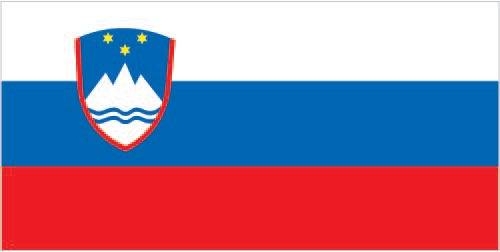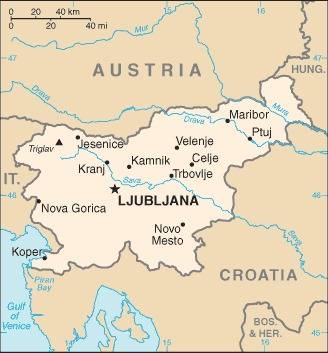109 Slovenia

Three equal horizontal bands of white (top), blue, and red, derive from the medieval coat of arms of the Duchy of Carniola. The Slovenian seal (a shield with the image of Triglav, Slovenia’s highest peak, in white against a blue background at the center. Beneath it are two wavy blue lines depicting seas and rivers, and above it are three six-pointed stars arranged in an inverted triangle, which are taken from the coat of arms of the Counts of Celje, the prominent Slovene dynastic house of the late 14th and early 15th centuries) appears in the upper hoist side of the flag centered on the white and blue bands.
Flag courtesy of the CIA World Factbook

Map courtesy of the CIA World Factbook

Predjama Castle in Slovenia, a large fortress built into a huge hillside cave.
Photo courtesy of the CIA World Factbook
Government
According to Britannica, Slovenia’s constitution, which was adopted in 1991, established a parliamentary form of government. A president, whose role is largely ceremonial, serves as head of state; presidents are popularly elected for a five-year term and can serve two consecutive terms. The head of government is the prime minister, who is normally the leader of the majority party in the National Assembly (lower house of the parliament), with which most legislative authority rests. Of its 90 members, 88 are elected by proportional representation to four-year terms, with the remaining two seats reserved for one representative each from the Italian- and Hungarian-speaking communities. The nonpartisan National Council, which represents economic and local interests, principally performs an advisory role, but it has the authority to propose new laws, to request the Constitutional Court to review legislative acts, and to initiate national referenda.
The občina (municipality) is Slovenia’s local administrative unit. The country is divided into hundreds of municipalities, about a dozen of which have the status of urban municipality. A popularly elected mayor, municipal council, and supervisory committee govern each municipality. Local government in Slovenia is chiefly responsible for municipal services, primary education, and the administration of social and cultural programs.
Slovenia’s judiciary consists of a Supreme Court and a system of lower courts, the district and regional courts, which hear both civil and criminal cases. The High Labor and Social Court deals with individual and collective labor issues and social disputes. The Constitutional Court is the highest body of judicial authority and upholds the constitutionality and legality of the legislative acts.
Judges are elected by the National Assembly after nomination by the 11-member Judicial Council. Every six years the National Assembly also elects an ombudsman, who is charged with protecting the public’s human rights and fundamental freedoms. The Constitutional Court is composed of nine judges who are elected for a term of nine years.
Civil Aviation Agency (CAA)
The Civil Aviation Agency (CAA) is the competent authority for flight crew licensing involving the conduct of theoretical and practical exams, and issue of licenses.
Airspace
SkyVector – Google Maps – ADS-B Exchange
ICAO countries publish an Aeronautical Information Publication (AIP). This document is divided into three parts: General (GEN), En Route (ENR) and Aerodromes (AD). ENR 1.4 details the types of airspace classes they chose to adopt from classes A through G.
Drone Regulations
Advanced Air Mobility (AAM) Regulations & Policies
Bilateral agreements facilitate the reciprocal airworthiness certification of civil aeronautical products imported/exported between two signatory countries. A Bilateral Airworthiness Agreement (BAA) or Bilateral Aviation Safety Agreement (BASA) with Implementation Procedures for Airworthiness (IPA) provides for airworthiness technical cooperation between the FAA and its counterpart civil aviation authorities.
Reciprocal acceptance of aviation safety-related approvals and services with the European Union Aviation Safety Agency (EASA) and Member States of the European Union are primarily governed by the U.S. – European Union Safety Agreement.
Advanced Air Mobility (AAM) News
None found by the author.
However, should you, the reader, happen to stumble across something to the contrary, please email the author at FISHE5CA@erau.edu and you may be mentioned in the ACKNOWLEDGEMENTS section of this book by way of thanks for contributing to this free eBook!
Short Essay Questions
Scenario-Based Question
You have been hired by a Drone Startup Company. Your boss has immediately assigned this job to you.
They need you to prepare a one-page memo detailing the legalities of using a drone to film the castle, pictured above.
They need you to mention any national laws and local ordinances.
They specifically want to know what airspace (insert pictures) you will be operating in and whether or not you need an airspace authorization.
Does it matter whether or not you are a citizen of the country?
Lastly, there is a bonus for you if, as you scroll through this chapter, you find any typos or broken links!
Short Essay Questions
- What are the drone categories?
- How is registration addressed?
- How is remote ID addressed?
- What are the model aircraft rules?
- What are the commercial drone rules?
- Are there waivers or exemptions to the rules? If so, for what?
- Would you share a link to an interactive airspace map?
- How is BVLOS addressed?
- How can you fly drones at night?
- How can you fly drones over people?
- Where do you find drone NOTAMs?
- What are the rules for drone maintenance?
- What are the rules for an SMS program?
- What are some unique rules not mentioned above?
- What are the C-UAS rules?
- What are the AAM rules?

